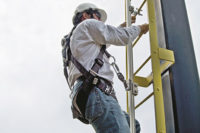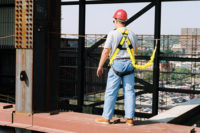The new instruction (1926.501 subpart M) cancels the original interim instruction issued more than 15 years ago and signals the first major fall protection regulation change in the residential roofing industry. OSHA issued the change in response to unexpected and avoidable worker injury and fatality statistics. With an average of 40 workers per year suffering fatal falls from residential structures, there is no doubt that stricter safety regulations are needed. For workers in the roofing segment of the residential construction industry, this is a positive change that will save the lives of many.
So what does this really mean for residential construction workers? Simply stated, this means:
- Fall protection equipment is required any time a fall of six feet or more is possible
- Acceptable forms of fall protection include guardrails, safety nets and active fall arrest systems (fall restraint is also acceptable)
- The 25 foot eave-to-ground height threshold no longer applies
- Slide guards are no longer the only form of fall protection equipment acceptable for workers, regardless of the roof pitch or height of roof eave
- In some low-slope roof applications, a combination of warning lines, guardrails, nets, monitors and personal fall arrest systems are acceptable
- On small, low-sloped roofs, a monitor alone may be allowed
- Interim OSHA instruction std 03-00-001, which provided some flexibility for fall protection, is cancelled
The phase focusing on education and training has recently been extended by OSHA, so now is the time to get up-to-speed on the things you’ll need to be in compliance. Any employer found not complying with the new OSHA regulations without an approved alternative plan after the changeover will be cited and face hefty fines. It is imperative that roofing companies take the new rules seriously and ensure they are providing proper fall protection equipment for the safety of their employees.
Sounds easy enough, but how are you going to go about changing the mentality and behaviors of your employees? Here are five simple steps to getting on track.
1. Get informed. Residential construction companies should not only be familiar with the new OSHA regulations, but also thoroughly understand the fine print. Stay current with facts and information provided by OSHA and residential fall protection equipment providers to ensure that your equipment and processes are in compliance.
2. Educate workers. While it’s important for leaders within a residential roofing company to fully understand the new regulations, it’s even more critical that every worker involved in a project is adequately informed. Be proactive in educating workers about the regulation standards and the appropriate fall protection equipment they must have in their toolkits.
3. Buy the right equipment. Companies can overcome any hesitation to compliance by supplying workers with comfortable, high-performing equipment. If equipment is easy to use and comfortable to wear, roofing workers will be more likely to want to wear it. Consider lightweight yet highly durable equipment that can be easily worn for the duration of the workday. For example, full-body harnesses should be constructed with strategically placed padding and soft, moisture-wicking materials that won’t chafe or rub. Fall protection products have come a long way in the last 15 years and are now more comfortable and user-friendly than ever before.
4. Implement training Programs. Training programs are a must. Having the proper equipment is important, but it won’t help the worker if the equipment isn’t used correctly. Make time for every worker to undergo fall protection training prior to working on the job site. Consider hands-on learning that approximates actual work conditions. If we’re talking about a harness, for example, there is no substitute for strapping into it, connecting to an anchor, experiencing how it feels and seeing firsthand what needs to be inspected before use. Overwhelmed? Don’t be. Most major fall protection manufacturers offer training courses to help residential construction workers learn how to use equipment correctly and comply with the new regulations. This means less stress for you and increased safety for your workers.
5. Show support. Lead by example. Leadership support for proper fall protection equipment and use is vital to worker compliance with safety at height requirements. Employees are more likely to take fall protection seriously if their leaders show the way. A lot of eager workers will be anxious to prove themselves diligent, hardworking and productive but, if they see safety equipment as a hindrance, they may forego it. Instill the value of fall protection safety as non-negotiable within your company, and never underestimate the value of leadership engagement.
Not only should fall protection equipment be worn because of the new OSHA regulations, but because it truly benefits roofers’ safety. Reiterate to roofing employees that accidents can happen to anyone, no matter how long they have been in the industry. Gravity never takes a break and using the proper equipment can help save their lives in the event of a fall. Be smart. Be safe. Be compliant.


